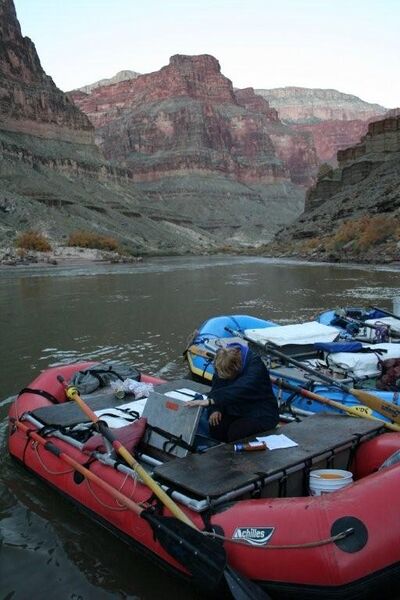Cooking Assignments
Cook Teams
Divvying up the work evenly among trip mates has several advantages: non-cooks have time to do some other camp activity during free time, taking turns avoids burnout, and it serves to limit the meals a less experienced cook will serve to the group... :>)
Most trips use some variation of the "cook crew" method, where participants are divided into teams and each team cooks on a rotating schedule. Some groups have crews of 3 or 4 people, while others assign responsibility to individuals who then recruit help in exchange for help on other rotations. Typically, there are several folks who enjoy food preparation and will help out others on their own down-times.
River trip groups may assign a whole day's worth of meals to a single crew (i.e. dinner and the following breakfast and lunch.) This group will be responsible for setting up and taking down the group bathroom the next night and morning, and then be “off” until it’s their night to start cooking again.
Some trips will assign a third duty, dishes. A trip of sixteen folks might work out a schedule like this:
Team 1, 2, 3, 4 and 5 Duties by day
Day 1 Day 2 Day 3 Day 4 Day 5 => repeat
Cook 1 2 3 4 5
Dishes 5 1 2 3 4
Bathroom 4 5 1 2 3
Off 2,3 3,4 4,5 1,5 1,2
Some trips will split couples up and put them on different cook crews. The advantage here is that a partner can be setting up or taking down a cook crewmember's camping gear while the other partner cooks.
Also, on some river trips, the groups will completely rearrange cook crew participants half way through the trip. This can be a good idea in helping people get to know others on the trip, and not feel like they are "stuck with Uncle Festus in the kitchen for the whole trip"!
The Kitchen Organizer
It is confusing when several people are diving into coolers and food storage to get things for a meal or putting things back and chaos can soon reign. Some trips will assign one person to keep track of where everything is located, direct consolidation as the cooler space or other food storage space is available, assign meals and oversee the menus. A sample Meal Information Sheet, when filled out by crews or individuals for their meal, helps the kitchen organizer schedule meals for different stages of the trip (i.e., fresh ingredients at the beginning of the trip vs canned ingredients at the end), and to ensure there are not too many menu repetitions and that the meals are relatively well balanced.
Also, this person should consider the activity planned for each day. For example, on the day the group will be visiting Deer Creek, good planning calls for a simple dinner, not a complicated one, since there will be less time spent in camp to prepare it. Likewise, if there is an all day hike planned, such as at Kanab Creek, or a layover at Nankoweap, making a pack-lunch at breakfast might be a good idea so that the cook crew for the day can participate as well.
The Kitchen organizer will pull together all the proposed menus and assign them a day. A meal calendar can help greatly. Use a page from a blank calendar or an Excel spreadsheet. See the Meal Calendar Sample. Be prepared to coach folks nervous about preparing a meal for a large group of people under primitive circumstances. This Food Tips Sheet or one you customize may help.
Click here to return to The Kitchen page.
Click here to return to The Food Pack page.
